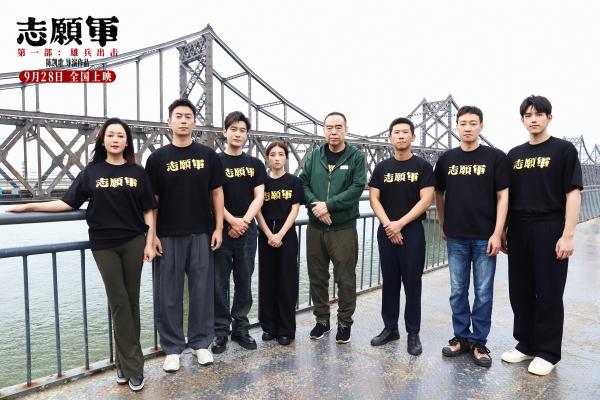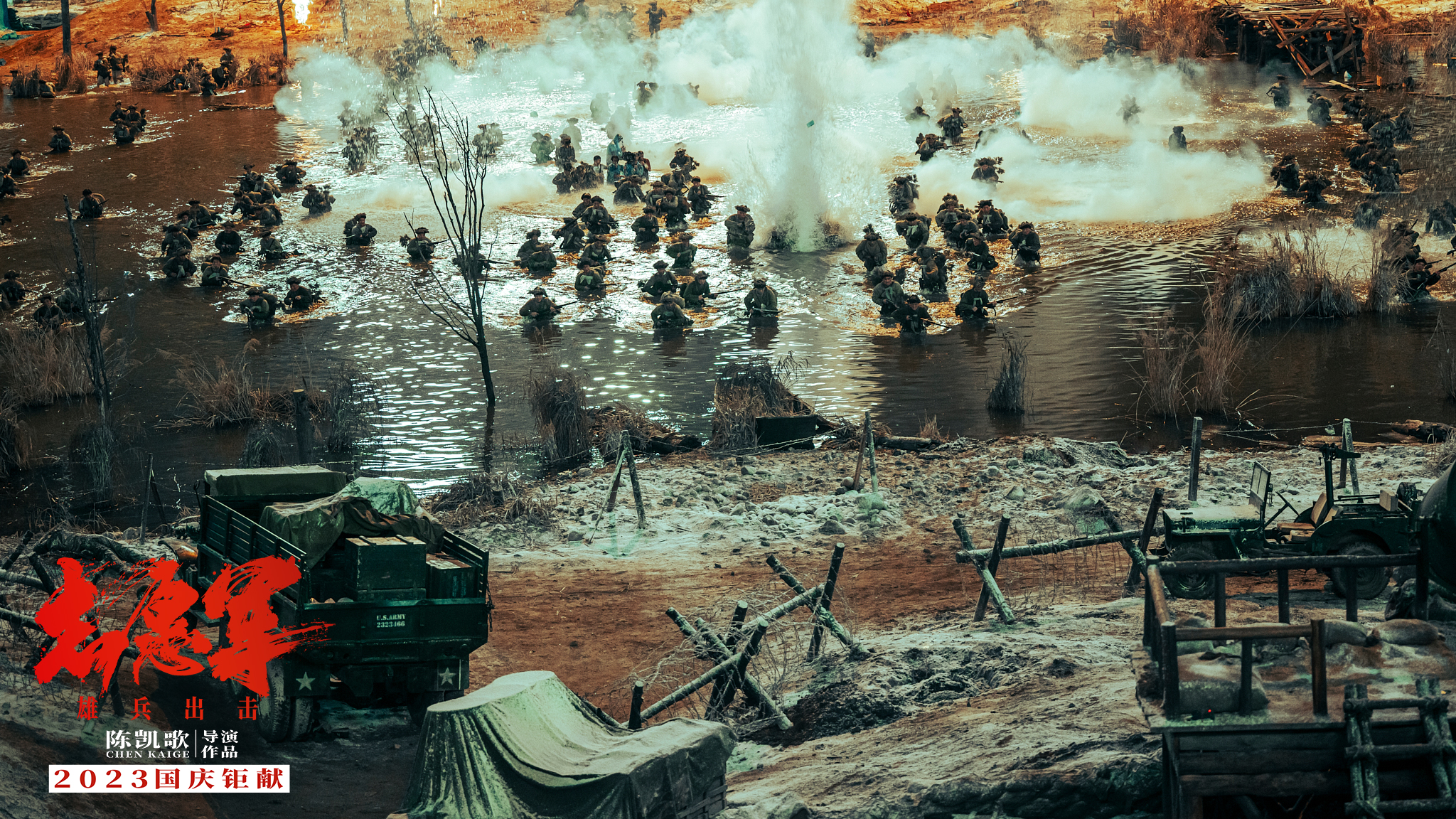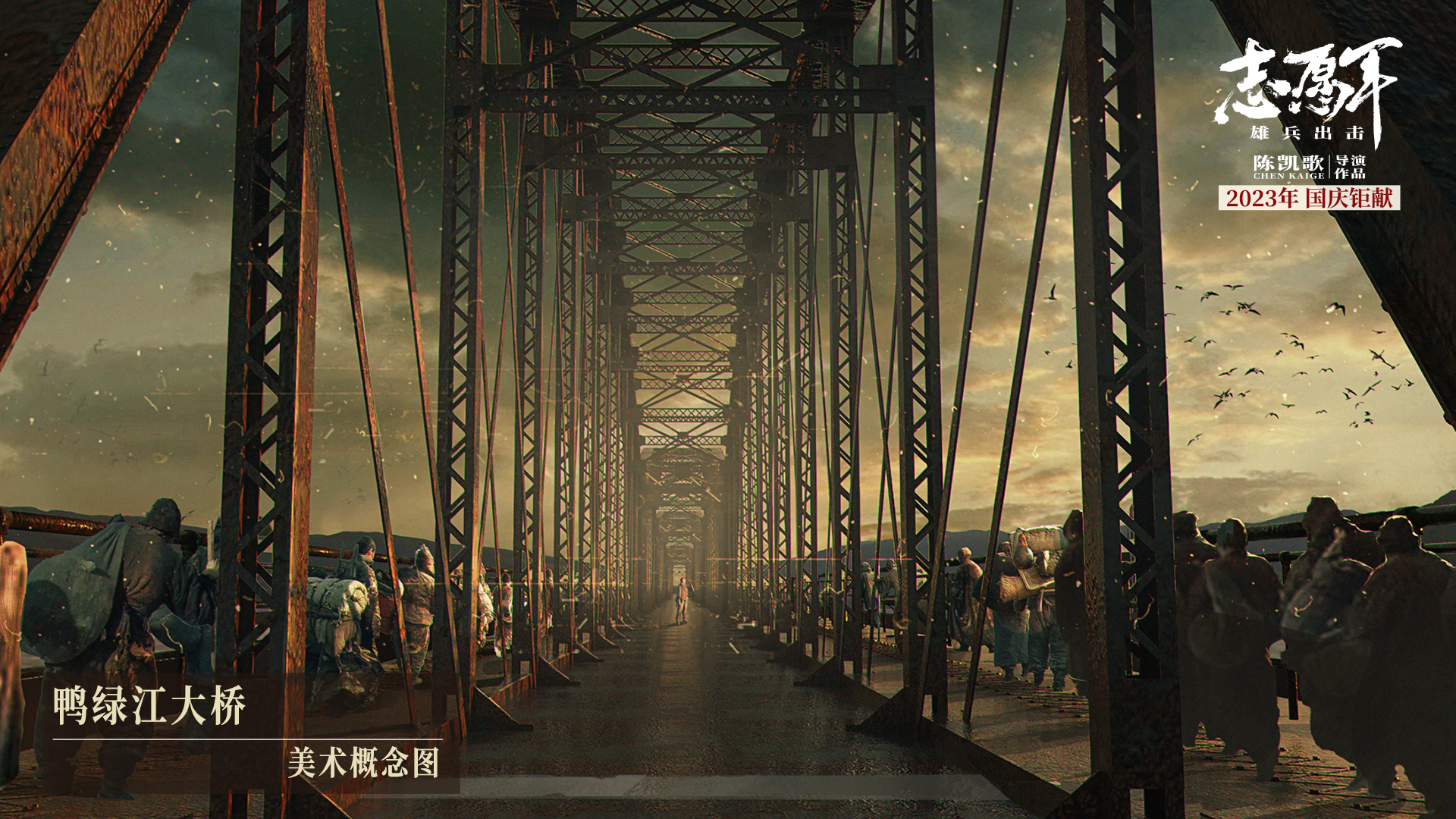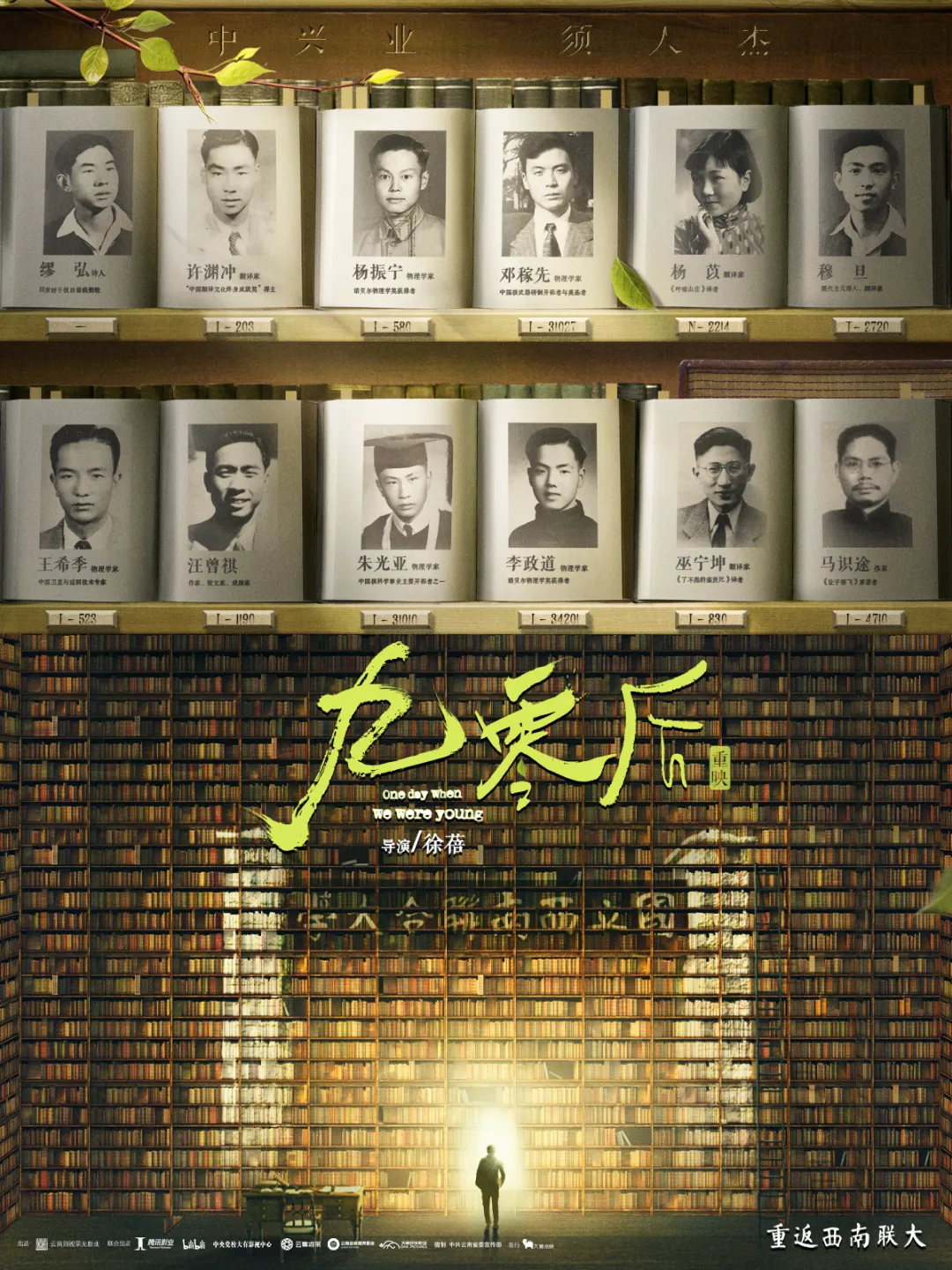
On September 28, the movie "Volunteers: Heroes Attack" directed by Chen Kaige was officially released. The five major highlights went deep into the front and behind the scenes, leading the national audience to relive the heroic story of the War to Resist U.S. Aggression and Aid Korea. A special episode of "The Loveliest People" was released on the day of the release, paying tribute to the heroic and unyielding fighting spirit of the Chinese People's Volunteers and the perseverance of the Chinese people. On September 27, the first stop of the roadshow was in the "Hero City" Dandong, setting off a wave of word-of-mouth enthusiasm. The main creators chatted about the details of the film with the audience, and gained a lot of emotion and strength. "Volunteers: Heroes Attack" is now in theaters and a nationwide roadshow is underway.
The film moved the audience at the Dandong station road show. Director Chen Kaige, along with producer and chief producer Chen Hong, and actors Xin Baiqing, Huang Xiaoming, Zhu Yawen, Zhang Zifeng, Wang Xiao, and Chen Feiyu attended the post-screening meeting and met with the enthusiastic Dandong audience. They communicate. Director Chen Kaige, who has just visited the Memorial Hall to Resist U.S. Aggression and Aid Korea, said that Dandong is a heroic city that once watched the volunteers enter Korea to fight. Now he is very happy to welcome batches of young people to watch movies here to pay tribute to the martyrs.

The main creators of "Volunteer Army" took a group photo in front of the broken bridge of the Yalu River
Actor Xin Baiqing also said: "I am very excited to step on the broken bridge of the Yalu River today and walk the path that the volunteer soldiers once walked!" Subsequently, the audience who could not suppress their excitement also expressed their feelings about watching the movie. A young viewer couldn't help but choked up several times when talking about the video in which the volunteer soldiers resisted the enemy's sophisticated weapons with their flesh and blood and built a peace line of defense with the spirit of "not fearing death." There were also audience members whose ancestors had fought in Korea and lamented: "The story with family memories can be truly shown on the screen today, and my ancestors have become living warriors in the film." There are also veterans of the War to Resist U.S. Aggression and Aid Korea. Watching the movie in person, the whole hall burst into applause, and the audience paid their highest respect to their fearless spirit of risking their own lives. The full-bodied characters leave a mark on the hearts of the audience, and the film tells the great deeds of the Chinese people in the form of group portraits.
Three key battles restore the real battlefield
The War to Resist U.S. Aggression and Aid Korea was the "war of founding the country" of New China. In 1950, in order to safeguard peace and gain long-term stability for the motherland, the Chinese military and civilians were united and began the three-year War to Resist U.S. Aggression and Aid Korea. There are many film and television works that show this "War of Founding the Nation", but the "Volunteer Army" trilogy is the first film to use a panoramic presentation to tell the audience the complete process of the War to Resist U.S. Aggression and Aid Korea, from the decision to send troops to the end of the war. .

"Volunteer Army: Heroes Attack" stills
70 years have passed by in a blink of an eye, and many people who experienced the war personally are no longer alive. For the younger generation, "volunteer army" has become a vague concept in books and ears. The movie "Volunteer Army" hopes to pay tribute to the "cutest people" and the ancestors who sacrificed their youth and lives for the motherland through images. Director Chen Kaige said: "I hope that the meaning of this film can make young people aware of that era, and also allow young people to understand and recall the contributions made by volunteer soldiers in the historical context of that time. .”
"Volunteers: Heroes Attack" is the first part of the "Volunteers" trilogy, and the story revolves around the decision to send troops and the first and second battles after entering the DPRK. Among them, the first battle at Liangshuidong, the attack on Sansuoli, and the bloody battle at Songgu Peak were all famous and key battles in the War to Resist U.S. Aggression and Aid Korea, and they were also the focus of the battle scenes in the film.
The battle at Liangshuidong was the "first shot" fired by the Chinese People's Volunteers after entering North Korea. On October 25, 1950, the 118th Division of the 40th Army launched an attack in the Liangshuidong area using the tactics of "blocking the head, cutting off the tail, and cutting off the waist". When the telephone line with the division command post was cut off, the 354th Regiment of the 118th Division made a decisive decision and relied on favorable terrain to launch an attack on the enemy, catching the enemy by surprise. In the end, after several hours of fierce fighting, the volunteers won the first battle in North Korea. The strategy and courage of the Chinese People's Volunteers gave the Americans a blow and demonstrated to them the Chinese people's determination to resist hegemony to the death.

"Volunteer Army: Heroes Attack" stills
During the second battle, the 113th Division of the 38th Army was ordered to attack Tokugawa. The weather was so cold that the volunteer soldiers had to take off their pants and wade through the river in order to avoid losing temperature. Not long after they captured Tokugawa, they received an urgent message from the military headquarters: They were required to travel 72.5 kilometers to Sanso-ri within 14 hours to cut off the US military's retreat. This was a forced march that exceeded the limit. People kept falling on the road, but the 113th Division did not slow down. In the end, they arrived at the battlefield five minutes earlier than the US military. The soldiers quickly entered the battle and successfully blocked the US military with the belief that they would win. This battle is enough to demonstrate the indomitable will of the volunteer soldiers in difficult circumstances.

"Volunteer Army: Heroes Attack" stills
On November 30, 1950, the 1st Battalion and 3rd Company of the 335th Regiment of the 112th Division of the 38th Army were ordered to block the US military at Songgu Peak. They fought fiercely with the enemy for several hours with the strength of one company. The Songgu Peak Blockade was one of the most heroic battles in the War to Resist US Aggression and Aid Korea. Almost all members of the 3rd Company responsible for the blockade died. In order to restore the brutal scene of this battle, more than 100 "burning men" were used at the shooting scene, and 8 cameras were working at the same time. Wei Chen, who plays the role of Dai Ruyi, the 3rd company commander, said: "There are corpses everywhere on the mountain top. When I saw this scene at the scene, the tragic scene shocked my eyes." I believe this battle will also shock the audience.
From "big" to "small", don't miss any details
Director Chen Kaige firmly believed in the early stages of creation: "Only when individual destiny and historical facts are blended together, can a huge explosive power be produced." For this reason, the director and the screenwriter sorted out the motivations and emotions of all the characters before filming started. , trying their best to make every character in "Volunteer Army" three-dimensional and full of emotion.
When shaping real historical figures, the creators not only restore the characters' well-known characteristics, but also focus on exploring their unique emotions. In the film, the audience can see Chairman Mao (played by Tang Guoqiang) briefly stunned after learning that his son was on the battlefield; see such a heroic and fierce commander Peng Dehuai (played by Wang Yanhui) and Li Moyin (played by Xin Baiqing) as friends "Take care of the family"; see the "tenderness" of Liang Xingchu (played by Wang Xiao), commander of the 38th Army, who is a "tiger general" but would rather violate discipline to protect the lives of his soldiers...
In the movie, Sun Xing (played by Chen Feiyu), Dai Ruyi (played by Wei Chen) and Yang Shaocheng (played by Yin Fang) of the 1st Battalion and 3rd Company of the 335th Regiment of the 38th Army are the main characters in the battle at Songgu Peak. Although their personalities are different, it does not prevent them from forming a team. The most tacit understanding of the "Iron Triangle", they were in high spirits when they entered the court and gathered together. The joy of reunion after a long separation was in sharp contrast with the hell-like tragedy on Songgu Peak, which became one of the most tearful plots in the film.
Director Chen Kaige once said that the "Volunteer Army" trilogy is his most difficult creation in his 40 years of filmmaking. The panoramic story capacity is a severe test for all the main creators, and the theme of the War to Resist US Aggression and Aid Korea makes people dare not relax. . The film took nearly two years to prepare, with tens of thousands of design drawings and concept drawings in total. Excluding outdoor scenes and the scenes built and arranged by the crew, the total area of the filming location is as high as 1 million square meters. In addition to the United Nations scene being restored to the same proportions, the crew went to Dandong to survey and map the Yalu River Bridge, and restored the Yalu River Bridge 1:1 based on historical data; they even built the entire courtyard of Zhongnanhai in 1950, covering an area of nearly 10,000 square meters. The creators tried their best to make these important scenes real, so that the actors could be immersed in them from the moment they walked in.

"Volunteers: Heroes Attack" concept map
"Volunteer Army" has more than 100,000 props. Art director Lu Wei once revealed that they bought many "antiques" from second-hand platforms, so many of the frontline battle scenes are old items from the 1940s or 1950s. Lu Wei said: "Old objects themselves have their own temperature. Although we can also make them, if they are real, then we try to use real ones." There are about 25,000 sets of costumes involved in the entire trilogy, of which nearly 50 % are the military uniforms of the Volunteer Army. Each set of clothes goes through seven or eight steps to make them look worn and worn in different stages. The volunteers also have more than 1,800 sets of backpacks.


